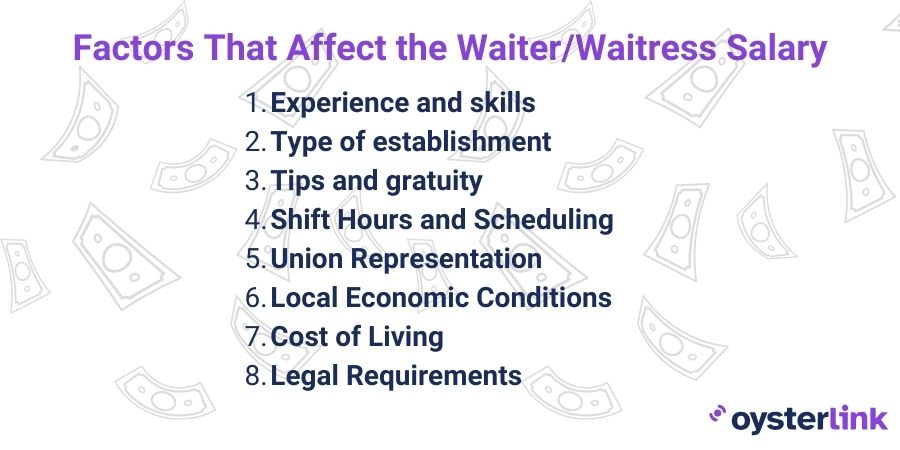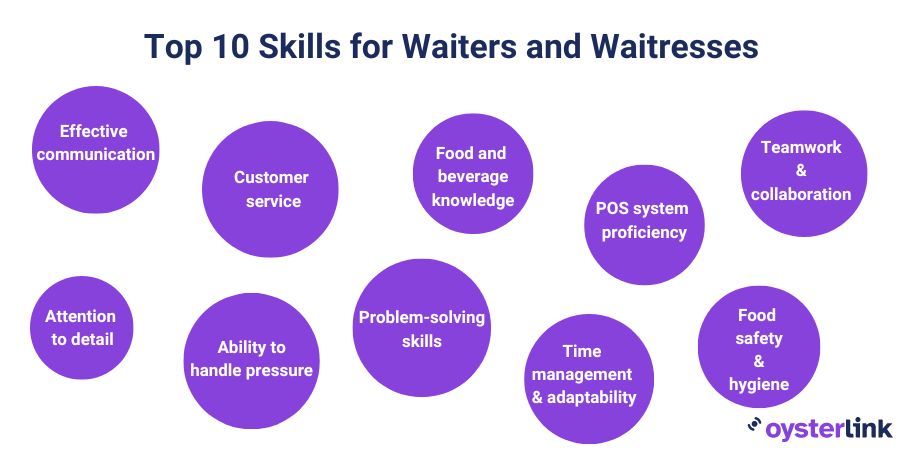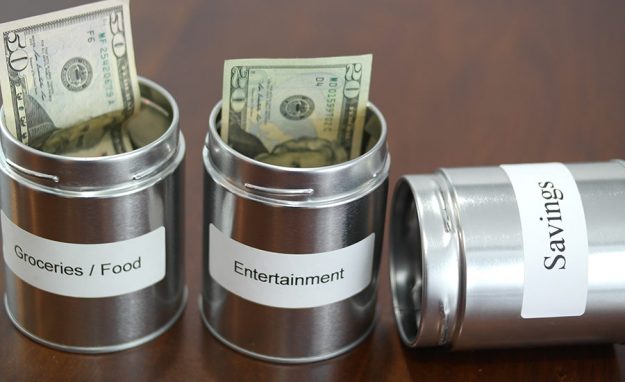How Much Does a Waiter/Waitress Make in the United States?
The average salary for a Waiter/Waitress in the United States is base plus tips per month or $36,530 base plus tips per year, according to the Bureau of Labor Statistics (BLS).
The average wage for a Waiter/Waitress is $17.56 base plus tips per hour.
Some Waiters and Waitresses can earn as little as $8.94 (10th percentile) base plus tips per hour, while others may earn as much as $28.89 (90th percentile) base plus tips per hour.
[Source: BLS]
This chart is interactive. Hover your mouse over different parts of the chart to see detailed data.
If you’re in the 90th percentile, you earn more than 90% of all the Waiters and Waitresses in the United States. Meanwhile, if you’re in the 10th percentile, you earn less than 90% of the group.
Note that tips form a significant part of a Waiter’s or Waitress’s overall earnings. At sit-down restaurants, the customary tip for waitstaff typically ranges from 15% to 20% of the total bill.
Annual Mean Wage of Waiters/Waitresses by State
[Source: BLS]
This map is interactive. Hover your mouse over different parts of the map to see detailed data.
The annual earnings for Waiters and Waitresses can vary significantly depending on the state they work in.
For example, in states with high living expenses such as Vermont or Washington, Waiters and Waitresses typically earn higher wages to cope with the increased cost of living.
On the other hand, in states like Montana or Mississippi, where the cost of living is lower, Waiter/Waitress salaries may be more modest.
Moreover, states boasting famous tourist attractions or vibrant entertainment scenes, such as California or Florida, may provide more attractive wages to attract skilled Waiters and Waitresses, particularly during peak seasons.
Factors That Affect Average Waiter/Waitress Salary
Aside from geographic location, here are other factors that influence the average Waiter/Waitress salary:
Experience and Skills
Experienced Waiters and Waitresses who possess strong communication, customer service and multitasking skills often command higher salaries compared to entry-level workers. Those with additional skills such as knowledge of wine or cocktails may also earn more.
Type of Establishment
The type of restaurant or dining establishment can significantly impact a Waiter/Waitress salary. Fine dining establishments or upscale restaurants typically pay higher wages compared to fast-food chains or casual dining venues.
Tips and Gratuity
Tips and gratuities form a substantial portion of a Waiter/Waitress income. The amount of tips can vary based on factors such as the restaurant’s clientele, service quality and tipping culture in the region.

Shift Hours and Scheduling
Waiters and Waitresses who work during peak hours, weekends or holidays may earn more due to increased customer traffic and higher tip potential. Flexible scheduling options or availability for special events can also contribute to higher earnings.
Union Representation
In some regions, the waitstaff may be part of a union that negotiates wages and benefits on their behalf. Unionized Waiters and Waitresses often enjoy better pay and working conditions compared to their non-unionized counterparts.
Local Economic Conditions
The overall economic health of the area can influence Waiter/Waitress salaries. In areas with strong economies and low unemployment rates, restaurants may offer higher wages to attract and retain staff in a competitive labor market.
Cost of Living
The cost of living in a particular area directly impacts the salaries offered to Waiters and Waitresses. In cities or regions with high living expenses, such as urban centers or tourist destinations, wages tend to be higher to accommodate the higher cost of housing, transportation and other necessities.
Legal Requirements and Minimum Wage Laws
National or local minimum wage laws and regulations play a significant role in determining Waiter/Waitress salaries. Employers must adhere to these laws, which may vary widely between jurisdictions.
Waiter/Waitress Salary in Major US Cities
Among the four major U.S. cities listed below, New York City is the top-paying city for Waiters/Waitresses, followed by Los Angeles, Miami and Chicago.
Annual mean wage
$37,360
Employment
54,080
Annual mean wage
$50,860
Employment
136,960
Annual mean wage
$34,340
Employment
67,270
Annual mean wage
$40,520
Employment
82,410
[Source: BLS]
High-Paying Cities for Waiters/Waitresses
| City | Avg Salary | Avg Hourly Wage |
|---|---|---|
| Miami, FL | 37,360 | 17.96 |
| Chicago, IL | 34,340 | 16.51 |
| NYC, NY | 50,860 | 24.45 |
| Los Angeles, CA | 40,520 | 19.48 |
Average Waitress Salary by State
Waiters and Waitresses in Vermont and Washington earn the highest average salaries, while those in South Carolina and Alabama earn the lowest.
| State | Avg. Salary |
|---|---|
| Alabama | $22,690 |
| Alaska | $36,150 |
| Arizona | $49,080 |
| Arkansas | $29,060 |
| California | $43,200 |
| Colorado | $41,630 |
| Connecticut | $41,760 |
| Delaware | $34,780 |
| Florida | $37,050 |
| Georgia | $28,840 |
| Hawaii | $44,620 |
| Idaho | $32,030 |
| Illinois | $33,910 |
| Indiana | $29,400 |
| Iowa | $30,050 |
| Kansas | $34,520 |
| Kentucky | $29,120 |
| Louisiana | $29,160 |
| Maine | $47,570 |
| Maryland | $39,430 |
| Massachusetts | $40,830 |
| Michigan | $39,590 |
| Minnesota | $25,850 |
| Mississippi | $24,610 |
| Missouri | $36,810 |
| Montana | $23,950 |
| Nebraska | $37,330 |
| Nevada | $32,360 |
| New Hampshire | $39,070 |
| New Jersey | $46,590 |
| New Mexico | $37,590 |
| New York | $51,040 |
| North Carolina | $29,990 |
| North Dakota | $35,210 |
| Ohio | $33,930 |
| Oklahoma | $24,590 |
| Oregon | $34,250 |
| Pennsylvania | $33,890 |
| Rhode Island | $41,900 |
| South Carolina | $22,770 |
| South Dakota | $28,590 |
| Tennessee | $29,210 |
| Texas | $29,350 |
| Utah | $35,480 |
| Vermont | $60,200 |
| Virginia | $37,580 |
| Washington | $57,960 |
| West Virginia | $33,410 |
| Wisconsin | $31,230 |
| Wyoming | $30,300 |
| District of Columbia | $51,970 |
Non-Monetary Benefits and Perks for Waiters and Waitresses
In addition to their salary, Waiters and Waitresses may receive non-monetary perks and benefits designed to improve job satisfaction, promote work-life balance and facilitate professional development. Here are some typical non-monetary perks and benefits that they may receive:
- Employee meals: Many restaurants offer free or discounted meals for their staff during shifts. This perk not only helps save money on food expenses but also ensures that Waiters and Waitresses are well-fed and energized for their work.
- Uniform allowance: Some establishments provide a uniform allowance or offer free uniforms to their employees. This helps maintain a professional appearance and reduces out-of-pocket expenses for staff members.
- Flexible scheduling: Flexible scheduling options allow Waiters and Waitresses to balance work commitments with personal responsibilities or other activities. This can include the option to request specific shifts or days off, accommodating employees’ individual needs and preferences.
- Paid time off (PTO): Waiters and waitresses may accrue paid time off for vacation, sick leave, or personal days, allowing them to take time away from work without sacrificing pay.
- Retirement benefits: Some restaurants offer retirement savings plans such as a 401(k) with employer matching contributions. This allows employees to save for their future and build financial security over time.
- Training and development opportunities: Restaurants may offer training programs, workshops or seminars to enhance employees’ skills and knowledge in areas such as customer service, food safety or wine appreciation. Investing in staff development not only benefits the individuals but also contributes to the overall success of the establishment.
- Health and wellness benefits: Some restaurants provide access to health and wellness benefits, such as gym memberships, counseling services or employee assistance programs. These resources support the physical and mental well-being of staff members, promoting a healthier and happier workforce.
- Recognition and rewards: Recognizing and rewarding outstanding performance can boost morale and motivation among Waiters and Waitresses. This can take the form of employee of the month awards, bonuses or other incentives based on performance metrics or customer feedback.
- Career advancement opportunities: Restaurants that prioritize employee development may offer opportunities for career advancement within the organization. This can include promotions to supervisory or management roles (e.g. Shift Supervisor or Assistant Restaurant Manager), providing a clear path for professional growth and advancement.
- Social events and team-building activities: Organizing social events or team-building activities fosters teamwork among restaurant staff. Whether it’s a holiday party, team outing or volunteer opportunity, these events help build a supportive and cohesive work environment.
According to Statista, here are the benefits employees are looking and would be willing to change jobs for:
[Source: Statista]
This chart is interactive. Hover your mouse over different parts of the chart to see detailed data.
Top 10 Skills Needed for Waiters and Waitresses
To excel at their job, Waiters and Waitresses must possess a combination of essential skills and attributes that contribute to providing exceptional service and enhancing the dining experience for customers. These skills include:
1. Effective Communication
Waiters and Waitresses need to communicate clearly and effectively with both customers and colleagues to ensure smooth interactions and foster positive relationships with patrons. This includes taking orders accurately, explaining menu items and addressing any questions or concerns customers may have.
2. Customer Service
Exceptional customer service is crucial for creating a positive dining experience. Waiters and Waitresses should possess strong communication skills, empathy and the ability to anticipate and fulfill customer needs promptly and courteously.
3. Attention to Detail
Attention to detail enhances customer satisfaction and helps prevent errors or misunderstandings. Waitstaff must accurately record orders, remember customer preferences and ensure that each dish is served correctly and according to the customer’s specifications.
4. Ability to Handle Pressure
Working in a fast-paced restaurant environment can be demanding, especially during busy times. Waiters and Waitresses must remain calm and composed under pressure, efficiently managing multiple tasks and prioritizing responsibilities to ensure timely service. The ability to handle pressure gracefully contributes to a positive dining experience for customers.
5. POS System Proficiency
Proficiency in using the point-of-sale (POS) systems is essential for entering orders, processing payments and generating receipts accurately and efficiently. Waitstaff should be familiar with the layout and functions of the POS system to minimize errors and ensure smooth transactions.

6. Food and Beverage Knowledge
A thorough understanding of the menu, including ingredients, preparation methods and potential allergens, is essential for providing informed recommendations and addressing customer inquiries. Waitstaff should also be knowledgeable about wine and other beverage options to offer suitable pairings.
7. Time Management and Adaptability
In a busy restaurant setting, effective time management and the ability to adapt to changing circumstances are essential skills for Waiters and Waitresses. They must prioritize tasks, manage multiple tables simultaneously and remain composed under pressure to provide timely and attentive service to all customers.
8. Teamwork and Collaboration
Collaboration among restaurant staff is vital for ensuring efficient service and a harmonious work environment. Waitstaff should be capable of working collaboratively with kitchen staff, Bartenders, Baristas and fellow Waiters to coordinate orders, expedite service and address any issues that may arise.
9. Problem-Solving Skills
Waitstaff must be capable of quickly and effectively resolving problems, such as incorrect orders, delays in service or customer complaints, as they arise, finding solutions that satisfy both the customer and the restaurant’s policies. Strong problem-solving skills help maintain customer satisfaction and prevent minor issues from escalating.
10. Food Safety and Hygiene
Understanding and adhering to food safety and hygiene standards is critical for ensuring the health and well-being of customers. Waiters and Waitresses should be trained in proper food handling procedures, including safe storage, handling and serving practices, to prevent contamination and foodborne illness.
Education Requirements for Waiters and Waitresses
Unlike many professions, working as a Waiter or Waitress typically does not require formal education beyond a high school diploma or equivalent. Most individuals enter the field with no prior experience and receive on-the-job training from their employers.
While formal education is not mandatory, completing courses or obtaining certifications in hospitality, customer service or food safety can be beneficial for those seeking to advance their careers in the restaurant industry.
How Much Do Similar Careers to a Waiter/Waitress Get Paid?
Waiters and Waitresses in the United States earn less than Line Cooks but more than Barbacks and Food Runners.
| Job Title | Average Salary |
|---|---|
| Line Cook | |
| Barback | |
| Food Runner |
As Waiters/Waitresses gain experience and demonstrate exceptional skills, they may have opportunities for advancement within the hospitality industry. This could include roles such as Head Waiter/Waitress, Bartender or Restaurant Manager.
Labor Laws and Taxes for Waiters/Waitresses
As a Waiter/Waitress, you need to be aware of the minimum wage, overtime pay, leave and tipping policies in your state.
Check out the guides below or view more labor laws:
- New York Labor Law Guide
- Illinois Labor Law Guide
- California Labor Law Guide
- Florida Labor Law Guide
To easily calculate federal, state and local taxes in your state, use our free Paycheck Calculator.
Total Tax
Net pay
Disclaimer: Please note that this paycheck calculator is designed to provide an estimate and should not be considered as professional tax advice. The actual withholding amounts and taxes owed may vary depending on individual circumstances and other factors. For accurate and personalized tax advice, we recommend consulting with a tax professional.
Waiter/Waitress Salary FAQs
Vermont pays the highest salaries to Waiters and Waitresses in the United States. This is largely due to the higher cost of living in the area compared to many states.
The policy regarding tip distribution varies depending on the restaurant or establishment. In some cases, Waiters and Waitresses may keep 100% of their tips, while in others, tips may be pooled and distributed among the staff or subject to tip-sharing arrangements.
It’s essential to clarify the tipping policy with your employer to understand how tips are handled.
In some restaurants, Waiters and Waitresses may receive periodic raises based on factors such as tenure, performance evaluations and the overall success of the establishment. Additionally, performance bonuses may be awarded for exceptional service, upselling or meeting specific sales targets set by management.
However, the availability and criteria for raises and bonuses can vary significantly depending on the restaurant’s policies and practices.
Yes, there can be seasonal fluctuations in Waiter/Waitress salaries, particularly in areas with tourism or seasonal dining trends. For example, earnings may increase during peak tourist seasons or holidays when restaurants experience higher customer traffic.
Generally, weekends and evenings tend to be busier times for restaurants, resulting in higher earning potential for Waiters and Waitresses working these shifts. Additionally, special occasions like holidays or events may also lead to increased earnings.
With the ongoing evolution of technology in the restaurant industry, there may be advancements in automation and online ordering systems that could potentially impact Waiter/Waitress roles and salaries.
Additionally, changes in consumer preferences, such as increased demand for healthier options or sustainable practices, may influence restaurant operations and compensation structures for waitstaff.



